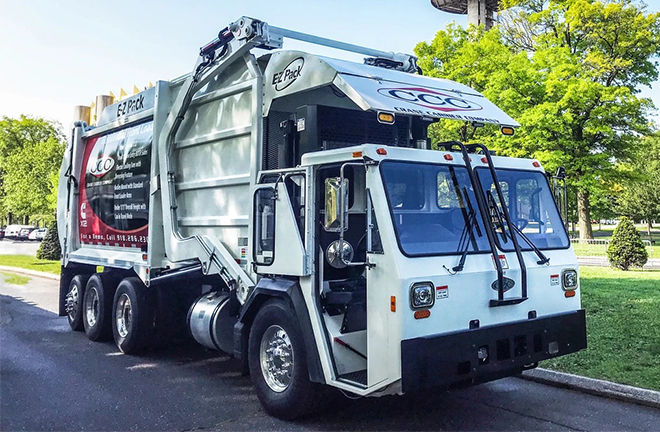For the past few years, the glamorous WasteExpo trade show has featured presentations and discussions of battery-electric trucks. Transport Dive reports that this year, there were several models on display, and one available for test drives. Manufacturers of electric refuse trucks at the show included Peterbilt, Battle Motors and Rubicon.
Various cities around the world have announced plans to convert their refuse truck fleets to EVs. New York aims to make its entire municipal vehicle fleet fully electric by 2040, and Los Angeles hopes to have a zero-emissions fleet by 2035.

The New York City Department of Sanitation began a pilot with the Mack LR Electric truck last September, and has gained some valuable insight about pickup cycles, actual versus expected battery drain, regenerative braking and more. Deputy Commissioner of Support Services Rocco DiRico told Transport Dive that charging presents several challenges, including a lack of sufficient space to complete fleet charging inside a facility.
Robert Potter, Sanitation Solid Resource Manager at Los Angeles Sanitation and Environment, emphasizes that municipalities must not overlook the multiple steps required to provide adequate electrical service.
“Electric is not easy,” he tells Transport Dive. “In our infinite understanding of trucks we have, I personally have a lack of understanding of electricity. So I thought, ‘Hey, I bought an electric truck I plugged into the wall next to the break room, tomorrow morning I’d load it up and drive off.’ That’s not the case.”
Potter found that most of the city’s facilities were not ready to support refuse fleet electrification. They needed to install not only the chargers, but electric boxes, transformers and other peripheral equipment—a process that could sometimes take up to two years.
“If I ordered a truck and I got it in nine months, it may sit for 14 months waiting for the ability to plug it in,” Potter told Transport Dive. “So, you have to be early in the game, looking at your electrical feed at your facilities to ensure that it has enough power—don’t make that assumption.”
Los Angeles Sanitation and Environment is currently negotiating with vendors, and expects to have a truck on the road in Q1 2022.
Source: Transport Dive

cost lasuna – buy diarex without a prescription himcolin online buy
cheap besifloxacin – purchase besifloxacin generic oral sildamax
order neurontin online cheap – order sulfasalazine online azulfidine where to buy
order probalan without prescription – order generic benemid 500 mg order carbamazepine 200mg
colospa 135 mg usa – purchase arcoxia online buy cilostazol 100 mg generic
order diclofenac 50mg generic – aspirin 75 mg cost aspirin 75mg uk
pyridostigmine 60 mg for sale – mestinon 60 mg tablet buy azathioprine no prescription
voveran pills – buy isosorbide 40mg pill buy generic nimotop
baclofen 25mg ca – piroxicam where to buy buy generic piroxicam 20mg
brand periactin 4mg – periactin 4mg ca order tizanidine for sale
buy mobic 15mg without prescription – maxalt 10mg for sale toradol for sale online
oral omnicef – purchase cleocin without prescription
buy artane generic – purchase cheap voltaren gel order cheap diclofenac gel
buy accutane paypal – order deltasone 40mg generic buy generic deltasone 40mg
purchase deltasone pills – order prednisolone 5mg online cheap elimite
buy generic permethrin for sale – purchase permethrin cream tretinoin cream tablet
order betamethasone 20 gm cream – adapalene usa buy generic monobenzone
metronidazole 400mg ca – buy flagyl online cheap cenforce 50mg pills
order augmentin 625mg without prescription – synthroid 75mcg drug purchase levoxyl generic
cleocin usa – where to buy clindamycin without a prescription indocin capsule
buy cozaar 25mg without prescription – order keflex without prescription keflex 125mg uk
eurax ca – buy crotamiton cream where to buy aczone without a prescription
buy modafinil generic – modafinil 100mg sale melatonin uk
generic zyban 150mg – xenical 120mg pills buy shuddha guggulu online
generic capecitabine 500mg – buy generic naproxen danazol 100 mg tablet
purchase alendronate without prescription – provera without prescription oral provera
buy generic norethindrone over the counter – lumigan for sale online buy yasmin tablets
estrace online – yasmin cost arimidex 1mg oral